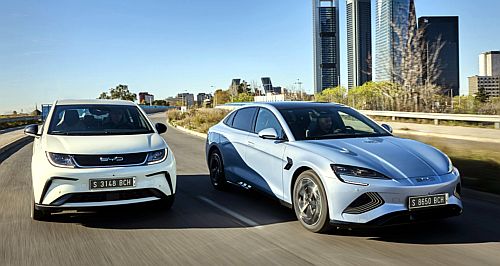News - Market Insight - Market Insight 2023Market Insight: BYD aims for pole positionBYD’s Toyota-toppling aim in Aus gains perspective as it nears 3m global annual sales11 Dec 2023 By PHILIP LORD THAT legacy automotive brands cannot rest on their laurels as the market quickly finds a place for new brands was demonstrated in Australia last week when Chinese brand BYD announced its ambition to overtake Toyota in this country by the end of this decade.
If BYD’s goal is realised, along with compatriot Chery that has a stated aim of reaching Australia’s top five best-selling car brands by 2027 and Indian car-maker Mahindra eyeing a top 10 spot among SUV sellers here, the local sales charts are in for a significant reshaping beyond the relatively recent establishment of Tesla, MG and Isuzu Ute among the mainstream players.
Given BYD was barely given a thought in the car-buyer’s mind before it arrived in Australia 18 months ago, can it really topple Toyota in just six years? The overseas picture might provide some clues.
BYD ditched models exclusively powered by internal combustion engine (ICE) vehicles in March 2022 and now only produces battery electric vehicles (BEV) and plug-in hybrids (PHEV).
That did not hurt the company at all as BYD sold 1,795,459 units in 2022, more than doubling the 2021 sales – most of them in its Chinese domestic market – while its sales tally to the end of November this year moves the car-maker close to its aim of three million annual sales, with 2.68 million already sold in 2023.
Looking back further – even just five years, the 2018 sales figure was just 225,136 BEVs and PHEVs. Aside from a correction during the COVID-19 lockdown years, BYD sales have been heading steeply upwards.
Meanwhile Tesla, the company that can be attributed to the rise of the popularity of the BEV in mature western markets (and is by far Australia’s most popular BEV brand), has a goal of 1.8 million total sales in 2023.
BYD is a long way from its roots as a company making only rechargeable batteries in 1996, and one that only began producing cars in 2003.
It has been reported that BYD has significant advantages with its vertical integration, which almost happened by mistake; early on it could not get the support of outside suppliers and so began building most of the components needed itself.
BYD’s battery packs, motors and electrical systems are all made in-house, its proprietary Blade battery design now supplied to other car-makers.
Even when attributing some of BYD’s success to the domestic market (where it has been reported that 90 per cent of the company’s sales are made) and government policies there favouring new energy vehicles over ICE, the company can hardly be described as one on the wane.
Its exponential growth is astounding, and a real worry for legacy car-makers globally if BYD gains ready acceptance in test markets like Australia.
BYD sold 10,975 units in Australia to the end of November, which represents a 1.1 per cent share of a new-vehicle market that is heading for an annual record-breaking result of 1.2 million sales this year.
The most established and most popular BEV brand here, Tesla, is way ahead with 43,924 sales (a 3.9 per cent share).
BYD would have to increase its sales 20-fold to potentially breach market leader Toyota, which has delivered 195,959 units in Australia to the end of November.
Looking at those figures out of context, it would be easy to assume that Toyota can hardly be worried. Averaged out, BYD’s YTD sales represent barely more than two weeks of production that the Japanese giant ships here.
So what is all the fuss about? Already, in barely 18 months, BYD sales volume has overtaken many established brands in Australia, most of it attributed to just one model, the electric Atto 3 medium SUV, and more recently, the Dolphin small electric hatch that has just been joined by the Seal medium sedan.
Atto 3 sales appeared to have plateaued since August, after a 1448 sales high in April, but it is early days yet.
The Atto 3 still averages more than 1000 sales a month, and there are more BYD models to come, including a ute and another SUV, both of which will arrive with PHEV powertrains that could gain more acceptance among Aussies not yet ready to transition away from the safety net a PHEV’s ICE provides.
BYD and its Australian distributor EVDirect introduced the Dolphin in October and the Seal started deliveries last month, so both will contribute to BYD’s local December sales and boost its annual result.
There is the promise of two new BYD models arriving every year until 2030. Last week BYD and EVDirect announced that significant investment in new retail stores and national expansion plans are being finalised.
The BYD Atto 3 is running sixth in its segment YTD, with 10,286 sales or 5.5 per cent share of a segment led by the Toyota RAV4 with 27,435 units earning it a 14.6 per cent share.
BYD’s Dolphin was third in the sub $40K small car segment in its full first month of sales (November) as reported by VFACTS. BYD sold 589 examples, against the first-placed Toyota Corolla with 1976 units and second-placed Hyundai i30 with 1566 units.
Looking at year-to-date 2023 figures, BYD at 10,975 sales is ahead of 30 other brands including Polestar, Peugeot, Renault and Skoda, while Honda (12,157 units YTD) in its sights.
Being confident of what the future automotive market looks like is a dangerous game, but one thing is certain: BYD cannot be dismissed as a flash in the pan; it has the wherewithal to follow up on its bold ambitions, provided it can win over Australian consumers.  |
Click to shareMarket Insight articlesResearch Market Insight Motor industry news |














Facebook Twitter Instagram